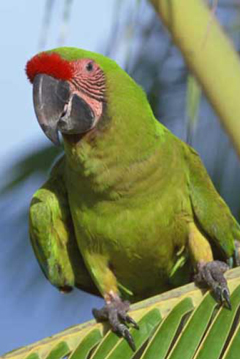Costa Rica protects green macaw by banning logging of mountain almond tree
Costa Rica protects green macaw by banning logging of mountain almond tree
Andrew Rothman
October 27, 2008
|
|
Costa Rica's high court has prohibited the cutting of a certain species of tree, in part because a highly endangered type of parrot uses the tree almost exclusively for nesting.
With one decision, the Sala IV constitutional court protected the mountain almond tree and the great green macaw, specifically in a sprawling area in northern Costa Rica. However, the court also ordered the Ministerio de Ambiente y Energía to spread the word to all its regional officials, thus protecting the tree throughout the country. The Sala IV also ordered the environmental courts to monitor compliance with the decision.
The tree is known in Spanish as the almendro amarillo, and it has the Latin name of Dipteryx panamensis. It is a slow-growing, towering tree that has wood so dense it only recently has become subject to lumbering. The wood resists termites, too.
The court decision annulled an order issued in February 2007 by the director of the Área de Conservación Arenal Huetar Norte that would allow harvesting of the tree.
The great green macaw is far more endangered than the almond trees. The Rainforest Biodiversity Group, which used to be called Friends of the Great Green Macaw, reports that only about 50 nests of the bird were found in a census and that some of the nests had not been occupied.
 A.M. Costa Rica file photo of the green macaw |
The group estimates on its Web site that only about 200 of the birds remain in Costa Rica, about 10 percent of the original population remains. The bird is called lapa verde in Spanish and has the Latin name of Ara ambigua.
The birds have a real advantage with the towering almond trees. The seeds or nuts provide food for the birds and other forest creatures.
Cavities in the tree collect water that the birds drink as well as supply safe locations for nesting. The objection to lumbering was brought to the Sala IV by a man identified in the decision summary by the last names of Carmiol Ulloa. He was doing so on behalf of the Asociación Red Costarricense de Reservas Naturales.
The Arenal Huetar Norte conservation area is some 4,220 square kilometers (1,629 square miles) that runs north from Zarcero to the border with Nicaragua. The area extends to a point west of Upala and shares a border with the Área de Conservación Tortuguero on the east.
The reserve network organization that brought the case is an association of some 110 private reserves.
The almendro tree was not commercially viable until the introduction of special carbon steel blades about 25 years ago due to the density of the wood. Some trees may be 50 meters, nearly 164 feet, tall. Protection of the trees and the birds have long been a goal of many environmental organizations, and a few years ago at one Texas university a concert was held to raise money to protect the trees and the bird habitat.
Andrew Rothman is the director of the Sarapiqui Conservation Learning Center in Chilamate, Costa Rica.